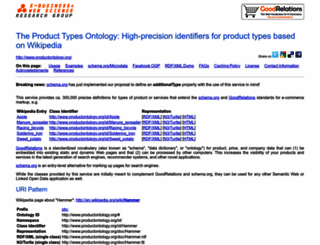The Product Types Ontology: Use Wikipedia pages for describing products or services with GoodRelations and schema.org
Page Load Speed
1.6 sec in total
First Response
235 ms
Resources Loaded
449 ms
Page Rendered
928 ms

About Website
Visit productontology.org now to see the best up-to-date Product Ontology content for United States and also check out these interesting facts you probably never knew about productontology.org
The Product Types Ontology provides good identifiers for more than 300,000 types of products and services for E-Commerce on the Semantic Web, based on Wikipedia
Visit productontology.orgKey Findings
We analyzed Productontology.org page load time and found that the first response time was 235 ms and then it took 1.4 sec to load all DOM resources and completely render a web page. This is quite a good result, as only 25% of websites can load faster.